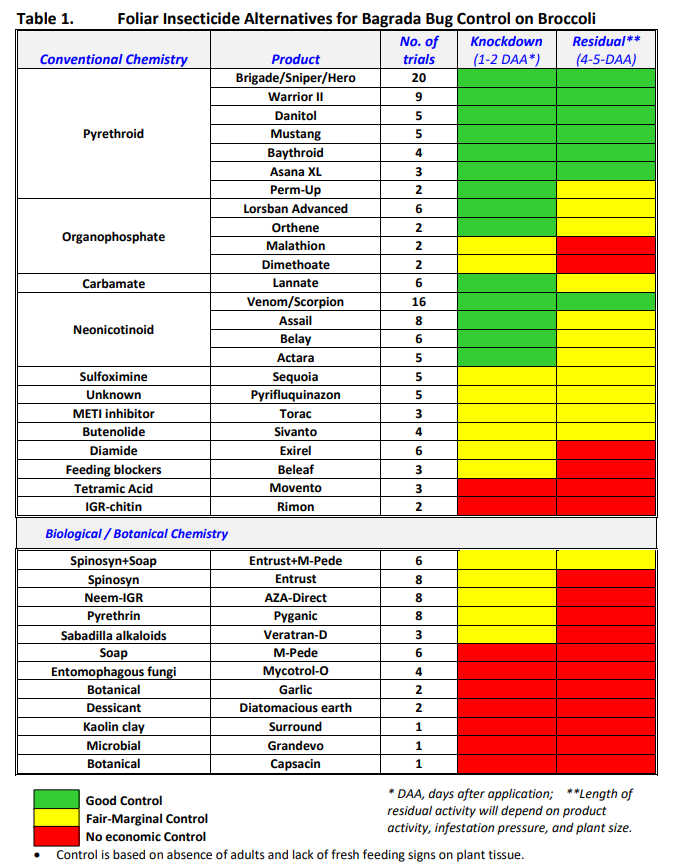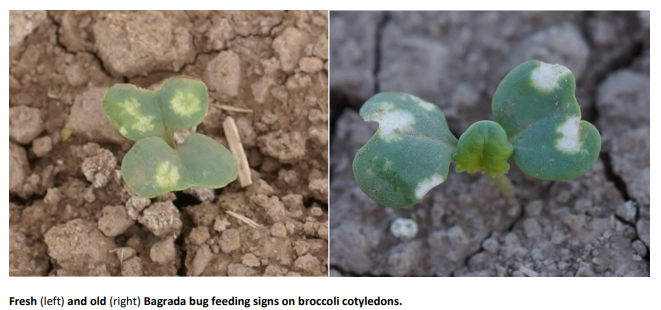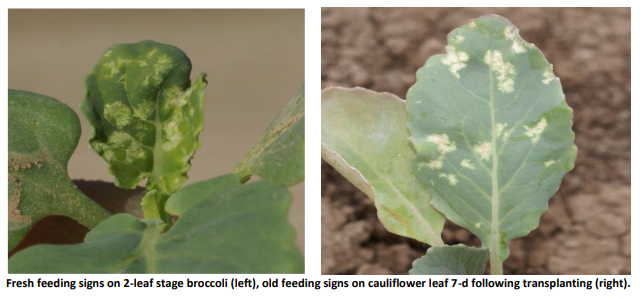Cropping System Considerations:
• Sudan grass, cotton and Bermuda grass crops may be considered key sources of Bagrada bug infestations for fall cole crop plantings. Anecdotal observations suggest that cole crops planted adjacent to or near these crops may be at a high risk from Bagrada bug infestations.
• Desert habitat can also be a source of Bagrada bugs due to the abundance of cruciferous weeds (London rocket, shepherds purse, wild mustards) and other host plants that flourish from spring and monsoon rains.
• Fields established adjacent to or near grassy areas, weedy drains, river bottoms and residential areas may also serve as a source of heavy Bagrada bug numbers, again due to the availability of host plants.
Monitoring and Scouting:
• When sampling for Bagrada, look for fresh feeding signs on cotyledons and young leaves (see images below).
• Inspecting plants for adults can be misleading during the early morning (6:00-8:00 am) as adults are generally most active in fields from mid-morning (10:00 am) to late afternoon day (4:00 pm) when temperatures exceed 90°F.
• During warmer times of the day, adults can often be found on, or adjacent to, plants with recent feeding damage.
• Sprinkler irrigation appears to repel the adults somewhat, so begin sampling soon after sprinklers are shut off.
• Transplanted cole crops: Begin scouting for Bagrada bug the next morning following transplanting. The bugs can be difficult to find on plants when sprinklers are on, so when sprinklers are turned off at night or early morning carefully inspect all the leaves for the presence of fresh feeding symptoms and adults.
• Direct-seeded cole crop plantings: Begin scouting immediately upon seedling emergence prior to the stand being "lined out" (3-4-days post-wet date in early September). Bagrada bugs have been observed feeding on broccoli seedlings just as the cotyledons are appearing. Damaged or desiccated seedlings that appear wilted can be a result of feeding. On larger seedlings at the 1-2 leaf stage or larger, fresh damage often appears on the young leaves.
Chemical Control:
• Preventing the adults from feeding on plant terminals and small cotyledons is critical to establishing and maintaining a quality stand.
• Based on preliminary research, a nominal action threshold has been established for bagrada bugs that triggers insecticide treatments when the number of plants with fresh feeding damage exceeds 5%.
• Contact insecticides (see Table 1) appear to provide the most effective control during stand establishment.
• Soil-applied neonicotinoid (e.g., imidacloprid, Belay, Venom) and diamide (e.g., Durivo/Coragen, Verimark) insecticides do not adequately prevent feeding damage on newly transplant crops or emerging direct seeded crops.
• Pyrethroids (i.e., Capture LFR) banded over the seedline at planting have shown to provide ~3-5 days control of adults on direct-seeded broccoli.
• Aerial application or chemigation with pyrethroids during germination and stand establishment can provide effective, short-term knockdown of adult populations on newly emerged or transplanted crops.
• On transplants, chemigations should be initiated upon the first signs of adults or fresh feeding damage. Our trials to date have shown that treatments for flea beetles have coincided with the presence of Bagrada bugs.
• On direct-seeded crops, consider a prophylactic chemigation when seedling first emerge (3-4 days after wet date), particularly if the grower has planted to a stand. Subsequent irrigation runs will likely dilute the chemical and may require additional treatments. Aerial applications applied at night after sprinklers are shut off may provide excellent knockdown of adults entering fields.
• Clothianidin treated broccoli seed (NipsIt) is now available. Research has consistently shown that this insecticide product can prevent Bagrada damage for 14-21 days following emergence (or about the 2-3 leaf stage).
• Once stands have become established, foliar sprays with pyrethroids (e.g., bifenthrin, Lambda cyhalothrin), chlorpyrifos, methomyl, and neonicotinoids (Venom/Scorpion) can effectively prevent feeding damage to plant foliage and terminal growth; length of control will likely depend on rates, coverage, spray frequency, tank-mix combinations, & duration of adult migration from outside the field.
• Research and anecdotal observations suggest that once heading brassicas plants (i.e., cauliflower, broccoli, cabbage) reach the 6-leaf stage they should not be susceptible to damage to the terminal growing point. However, leafy brassica crops may be susceptible to cosmetic damage to leaves from bagrada feeding for much longer periods.
• Control in organic cole crops can be difficult. Using transplants can improve stand establishment, but adults still need to be controlled to prevent terminal damage until plants reach the 6-leaf stage. A combination of Entrust (8 oz) and M-Pede (2%) has shown to provide the most promising efficacy in organic crops.


